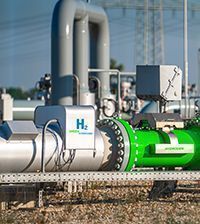Solution: HIC, hydrogen embrittlement and other hydrogen induced degradations
Solution: HIC, hydrogen embrittlement and other hydrogen induced degradations
HIC, hydrogen embrittlement and other hydrogen induced degradations
In which region do you need this solution?
Hydrogen (H2) is a rather small molecule and has specific properties, that make that its interaction with materials is different from that of many, if not most, other gasses and liquids.
The fact that hydrogen can cause embrittlement of steel and other metals, and can cause cracks or make cracks grow, is well known in the industry. However, with a growing hydrogen industry, also the applications in which H2 will be used is rapidly growing. And so, many more materials will be exposed to hydrogen and many more processes will see H2 as (part of) their feedstock or (by-)product. The literature with regards to hydrogen and its impact on metal materials is perhaps not as detailed as needed at present, which leads to a strong need in the market for materials scientists with proper understanding and experience with Hydrogen. TÜV AUSTRIA has an extensive network of material experts amongst its various testing and inspection affiliates. Besides those internal resources, we also work closely with reputed universities and research institutes.
For any question with regards to HIC, hydrogen embrittlement and other hydrogen induced degradations, please contact us.
Realizing an hydrogen economy cannot be regarded as just an industrial task alone. Rather, the industry’s global objective is to collaborate with other parts of society to achieve a sustainable future and provide our children and grandchildren with a livable environment. Around the world, hydrogen activities are developing rapidly and new projects are announced.
It is very likely that, at least in the transition period, but probably in the long term, the existing infrastructure will also be used to transport hydrogen.
That is why the current discussion amongst engineers does not only look at the materials to be selected in new designs, but also at the materials that are used in the infrastructure already present. For example, in the natural gas infrastructure, the main pipes are made of ferrous metals (mainly steel), while locally polymeric materials are used. Finally, copper is the material of choice in most domestic applications.
Research on the physical or chemical interaction between hydrogen and polymer is rare and it should be noted that hard evidence from the literature is still lacking.
Hydrogen embrittlement of copper is only known if the alloy contains oxygen (in the form of copper oxides). This type of degradation is not very likely because copper pipes are usually produced from oxygen-free copper. Furthermore, copper is usually only applied at low pressures and low temperatures, reducing the risk of material degradation.
In contrast, different degradation mechanisms on steel are known for both hydrogen derived from the gas phase and hydrogen formed by electrochemical loading. It is known that if mechanical loads and/or hydrogen are present, hydrogen can penetrate the steel even at room temperature. This, in turn, causes the steel to weaken, making it more likely to fail. In addition, atomic hydrogen can penetrate the steel and then recombine locally at a defect which then causes a local very high pressure of di-hydrogen. This in turn can eventually cause the formation of a blister. Also, at high temperatures, gaseous hydrogen can attack carbon and low-alloy steels, resulting in decarburization and the formation of cracks, leading to premature failure. In addition, micro perforation by high pressure hydrogen (found in compressors) and hydride formation (found for several elements, including titanium) could also be degradation mechanisms to be aware of.
TÜV AUSTRIA has the relevant technical knowledge and experience to assist you with these issues. Hydrogen and the issues surrounding hydrogen embrittlement and degradation mechanisms are our daily reality and we are intensively involved in many hydrogen projects. TÜV AUSTRIA also has a wide range of expertise, knowledge and a geographically very extensive network (i.e. more than 50 offices in 27 different countries) to contribute to the success of your hydrogen projects.









